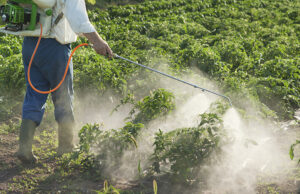Action Alert: Protect farmers from toxic dicamba drift!
Dicamba drift, whether from the spray or volatilized gas, can devastate crops, adjacent ecosystems, and entire landscapes.
Have you heard of Dicamba? It’s a chemical that farmers use to kill unwanted plants in their fields. Since it kills pretty much everything, farmers used to only apply it before the growing season to “burn down” the fields. But since 2016, thanks to Monsanto’s genetically engineered crops, farmers started to spray it throughout the year because their GMO seeds were designed specifically to have it sprayed on them throughout the growing season.
But their neighbors’ crops aren’t resistant! And it’s not just their immediate neighbors, either. Dicamba is easily volatilized (turns into a gas) and can drift for miles, harming farmers at a significant distance. Not to mention the monarch butterflies, bumblebees, and many other important pollinator species.
Dicamba drift, whether from the spray or volatilized gas, can devastate crops, adjacent ecosystems, and entire landscapes. This poses a serious threat to rural economies and farmers growing vulnerable crops. Conventional farmers will lose crops, while organic farmers will lose both crops and certification, resulting in an economic unraveling of already-stressed rural communities.
Bayer (which now owns Monsanto) has yet again asked the federal Environmental Protection Agency (EPA) to approve Dicamba for use on its genetically engineered crops. This comes after two federal courts have ruled that EPA previously improperly approved dicamba given the reams of evidence about the harms it causes!
Bayer has offered some changes in the proposed label language, but that doesn’t solve the core problems. GMO cotton growers would still be allowed to spray until July 30th, the hottest part of the summer when volatility is at its worst, meaning massive drift injury wherever GMO cotton is grown. GMO soy growers would be required to stop spraying in mid-June, but that still leaves all too much time for drift and volatilization … even assuming growers didn’t simply ignore the label.
The Texas wine industry is at particular risk, because the vineyards are in the same region as large farms growing GMO cotton. Read this article from Bingham Family Vineyards: Dicamba Chemical Risks: Threat to Texas Wine and Agriculture (binghamfamilyvineyards.com)
It is critical that the EPA rejects Bayer's request to protect our farmers, environment, and rural economies from the devastating impacts of Dicamba. The call to action is clear: we must stand united in urging the EPA to prioritize sustainable farming and the health of our communities over corporate interests.
How to Take Action:
It's time to stand up and protect our farmers, our environment, and our rural communities from the devastating effects of Dicamba drift. Your voice matters, and together we can make a difference. Here’s what you need to do:
1. Submit Your Comments to the EPA: Go to THIS LINK and click on the blue button for “comment”. Be sure to do this by the deadline on July 5, 2024.
2. Express Your Concerns: When writing your comments, you can highlight 1 or 2 of the following talking points. Your comments can be as short (or long) as you want:
- Risk to Nearby Farmers: Explain how approving dicamba for use on GMO crops threatens the livelihoods of conventional and organic farmers due to the risk of crop damage from drift.
- Environmental Impact: Emphasize the high volatility of dicamba and its propensity to drift, causing harm to adjacent ecosystems and vital pollinator species.
- Water Supply Threat: Discuss the potential contamination of water supplies from dicamba drift, posing a health risk to communities.
- Economic Consequences: Describe the potential economic fallout for rural communities as farmers lose crops and organic certification, leading to financial instability.
- Inadequate Label Changes: Point out that the proposed label changes by Bayer do not adequately address the core issues, as they still allow spraying during peak volatility periods.
3. Share Your Personal Story: If you have a personal experience with the negative effects of Dicamba drift, share it. Personal stories can be powerful and persuasive.
4. Spread the Word: Encourage friends, family, and your community to also submit their comments. The more voices we have, the stronger our impact will be.
By taking these steps, you are helping to safeguard our agricultural communities, protect our environment, and ensure that sustainable farming practices can thrive. Let's make sure the EPA hears us loud and clear: Dicamba has no place on our fields.
Act now and make your voice heard!
####
